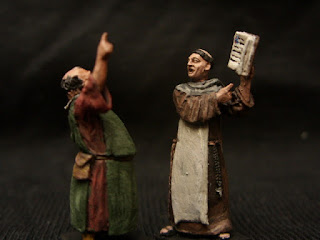Bit of a long one this, and I hope it makes some sense. Words and pics are ok, but better is with moving pics, but as any films I make turn out blurred etc, I´ll stick with this method.
Things needed. Scissors, sharp modelling knife, tweezers, darning needle, a pen (the diameter of which will decide the diameter of the gibbet, the bigger the pen, the bigger the cage) some thin black card and woodglue (not in pic)
Cut lengths of card as thin and as straight as you can. Basically, it´s just a matter of laying out a set of 8 (or any even mumber) of strips, then using the darning needle, dab a blob of glue on each horizontal strip and then lay a strip horizontally across.
The space between the "bars" I judged by eye and the width of a bod´s head. If it looks like the bod could squeeze through the bars, they are too far apart.
The first two strips can cause a bit of trouble as the horizontal strips tend to move about a lot, but when the first two are added it all solidifies. Occasionally check that the contact at the joins by gently pressing them together with the tip of the darning needle.
On each cross I´ve added a bit more woodglue. This not only strengthens the mesh but it looks a bit like a weld and gives a rough iron work appearance.
When glueing the strips together, it´s best to do this on a shiny surface and occasionally move the mesh about to prevent it accidently sticking down.
Roll the mesh (when it´s fully dry) around the pen. When the mesh has taken up a rolled shape, wrap it around the lid of the pen..not the body, it will have too small a diameter for later on. Cut off the sides (the horizontal strips), leaving enough to overlap and glue together.
At one end of the cage, cut all the strips off leaving a short tab above top horizontal bar. Use the pen to curve 4 of the strips into crescent shapes.
Here I´ve removed the cage from the pentop to make it easier to cut the strips off. It gets re-inserted as in the pic below
The bottom of the cage is a bit fiddly. Basically, cut 4 strips off one side of the cage, flush with the horizontal bar leaving the 4 other strips on the other half of the cage. Using the tweezers, bend each strip over into an "L" shape, so that the foot of the "L" fits inside the cage. With the darning needle add a blob off glue, push the foot of the "L" in and hold it in place with the tweezers until it drys.
To make the hook for the top of the cage or for the rest of the Gibbet, take a piece of the cut off strips, fold around the darning needle, add a blob of woodglue and hold shut using the tweezers.
When dry and still holding closed with the tweezers, bend the sides out, cut to desired length and glue to the cage. This technique is also usefull for making hinges.
Add the hook, and paint black, then add an anthracit drybrush...
OOPS!!!!! I forgot something!!
There´s no bod in the cage!!!! It would normally be added before the bottom of the cage is glued shut..and end up looking like THIS, but now it´s a bit late...but!!!.............
.....waste not, want not.....I´ve cut the cage into two halves, re-made the top, added legs and bingo! Two Braziers! :-D





























